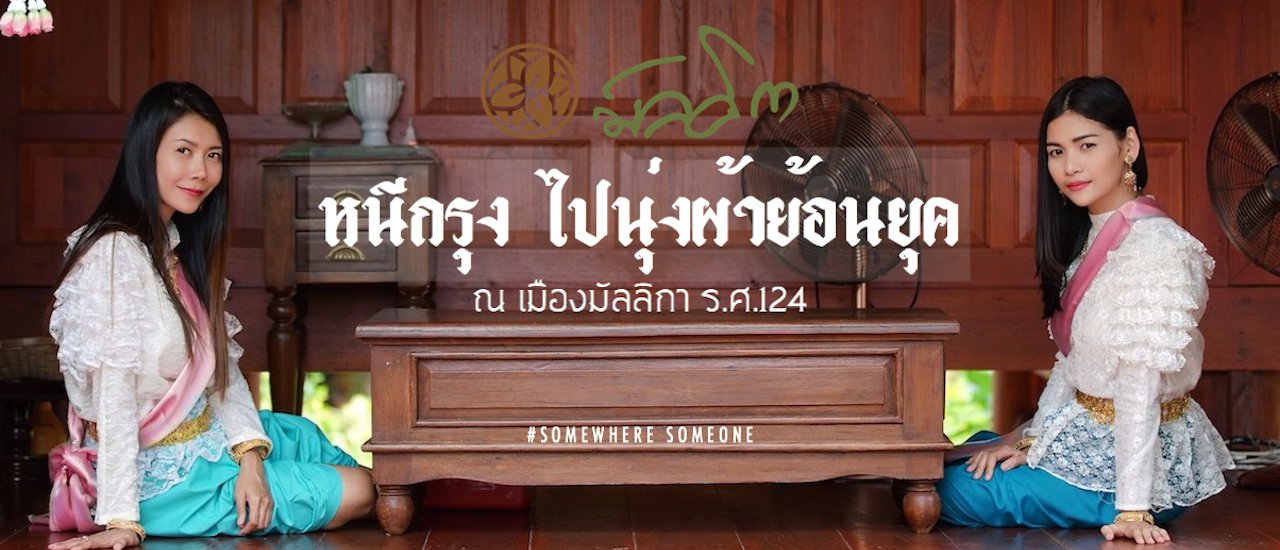Escape the city and embrace the past at Mallika R.E. 124, where you can immerse yourself in the charm of vintage Thai attire.

This trip started with our friends and I wanting to find a place to visit near Bangkok, a 2-3 hour drive away. We decided on Kanchanaburi, and the program for this Kanchanaburi trip included Mallika City on our list of tourist attractions this time. Mallika City has been open to tourists since the end of last year. After we had been eyeing this place for a long time, we finally got to visit.

Mallika City R.S. 124: A Journey Through Time
Mallika City R.S. 124, situated on 60 acres in Sai Yok District, Kanchanaburi Province, Thailand, offers a captivating glimpse into the late era of King Chulalongkorn (Rama V). Established to commemorate the abolition of slavery in 1875, the city meticulously recreates the ambiance of that pivotal period in Thai history.
Visitors to Mallika City embark on a journey through time, immersing themselves in the sights, sounds, and customs of the late 19th century. The meticulously crafted architecture, traditional attire worn by the staff, and authentic activities transport guests to a bygone era.
Reaching Mallika City is a straightforward endeavor. Situated along Highway 323, the city is easily accessible by car. Travelers need only follow the road towards Sai Yok, where they will find Mallika City conveniently located next to a Bangchak gas station, near the entrance to Prasat Muang Sing Historical Park.
A visit to Mallika City promises an enriching experience, offering a unique opportunity to delve into Thailand's rich cultural heritage and gain a deeper understanding of its historical evolution.


Upon arrival at Mallika R.E. 124, visitors are greeted by a towering white city wall adorned with a grand red gate. Peering through the gate, one feels transported to another era.

Admission Fee: Adults 200 Baht, Children 100 Baht
Admission fee + Dinner + Show 700 baht (10% discount promotion)
Before entering the venue, visitors are required to dress appropriately in traditional Thai attire. The venue offers rental services for those who do not have their own Thai outfits.

Rental Rates for Traditional Thai Costumes
Women
Style 1: Blouse, sarong, accessories, and umbrella - 200 baht
Style 2: Lace or puffed-sleeve blouse in the style of King Rama V, with a silk sash, sarong, accessories, and umbrella - 300 baht
Men
Style 1: Mandarin collar jacket, sarong, and waistband - 100 baht
Style 2: Royal court jacket, sarong - 300 baht
Children
Round-neck collar blouse for girls and Mandarin collar jacket for boys - 50 baht

Is it possible to visit this place without wearing a Thai costume? While it is technically possible to enter without one, we believe that wearing a costume would enhance the experience and create a more immersive atmosphere. Since everyone in the city dresses in traditional Thai attire and uses archaic language, donning a costume would allow you to blend in and feel as though you have truly traveled back in time.
We chose to wear lace dresses in the style of the reign of King Rama V, which gave us the feeling of being noblewomen.

After changing clothes, lockers will be provided for storing personal belongings.

Before entering the city, we need to exchange our money because the city does not use Thai baht. Instead, they use "satang", which are coins with holes in them. The exchange rate is 1 satang = 5 baht. There are money exchange points both outside near the ticket booths and inside the city at the Siam Commercial Bank.

Once you have exchanged your money, we will take you on a tour of the city.

The city can be explored on foot, or for those who prefer, rickshaws are available for a fee of 50 baht. Alternatively, visitors can simply enjoy taking photos without any charge.



Upon entering the gate, visitors are greeted by the "Saphan Han" bridge, a replica of its historical counterpart. The name "Saphan Han" translates to "turning bridge" due to its original design. In the past, the bridge consisted of a single wooden plank spanning the canal. One end was fixed in place, while the other remained unattached, allowing it to be rotated to facilitate the passage of boats. During the reign of King Rama V, the bridge was transformed into a wide, curved wooden structure. Small shops lined both sides of the bridge, with a walkway in the center.



The bridge is flanked by rows of small shops, with a walkway in the center.


This bridge was a favorite spot for King Rama V to visit and purchase dried fruits imported from abroad, such as dried persimmons and various other fruits. We took the opportunity to try our hand at being vendors and even got to sample dried pomelo peel.

Crossing the Saphan Han bridge, you will encounter a vibrant building complex known as the "Commercial District," which replicates the historic Phraeng Nara Road area from the year 1881. This district encompasses significant commercial hubs of the past, including Phraeng Phuthon Road, Phraeng Sanphasat Road, Yaowarat, and Bang Rak.


This area offers a variety of Thai beverages, savory and sweet dishes, and traditional snacks, some of which are rarely found nowadays due to the lengthy preparation time. The vendors here use charcoal stoves for all their cooking, and you are welcome to observe and photograph the cooking process. Alternatively, you can purchase and sample the food. We tried several dishes, and the flavors were delicious and authentic. Some of the snacks were new to us, and we were delighted to try them for the first time here.



Follow me, and I will take you to taste rare royal Thai cuisine and desserts.

Pork satay, royal recipe, with tender marinated pork that is truly delicious.

Sticky rice with various toppings, including dried fish, shrimp, and shredded pork.

Thong Ek and Saneh Chan desserts are traditional Thai treats that are becoming increasingly difficult to find due to their intricate preparation process, which requires considerable time. Nowadays, they are primarily served at auspicious events or significant gatherings. If you're interested in savoring their flavors, you can visit this establishment, where they are available daily. Alternatively, you can try making them yourself.

Khanom Chan is a popular Thai dessert that is still widely available today. However, only a few vendors use natural colors, such as green from pandan leaves and purple from butterfly pea flowers. We tried a sample and found it to be delicious and very fragrant.

Another rare dessert is "Bua Loi Dahn Meuk," which, to be honest, we only learned about here.
The batter, made with butterfly pea flower water, is poured into a "talae" cup, resembling a "khanom nam dok mai" (flower water dessert), and an egg yolk is placed in the center.

This shop sells colorful "Chomuang" and "Look Choup" desserts, made entirely with natural food coloring.

Chormuang, a traditional Thai dessert with both pork and shrimp fillings, is becoming increasingly difficult to find. When available, it tends to be quite expensive.
A pastry made from dough, filled with various ingredients, and shaped by pleating the dough.

Khanom Look Choup is a traditional Thai dessert made from mung beans that are mashed, sweetened, and molded into the shape of various fruits. It is a popular and well-known dessert among Thai people.

Upon tasting the "Chomuang" dessert, we found its flavor to be reminiscent of "Saku" with a pork filling, though the "Chomuang" filling was slightly sweeter.

"Khanom Luem Klin, a rare and elusive Thai dessert."

Traditionally, grilled sticky rice is filled with taro or soybean paste.

Let's try grating coconut together. It feels like going back to childhood, because I used to help my grandmother grate coconut like this.

Aromatic and sweet pandan leaf cup cake.
As a reminder, all shops in the city only accept Rupees.

If you find yourself running low on funds after enjoying the delights of the city, fret not! Two Siam Commercial Bank branches are conveniently located within the city walls, ready to assist you with your currency exchange needs.

The building is brightly colored.


You can walk around, and if you get tired, there are chairs at various points where you can rest.

The City View Tower, modeled after the Prison Tower, is a watchtower used to prevent prisoners from escaping. Visitors can climb the tower for a 360-degree view of the city.



From a bird's-eye view, it is noticeable that the city is surrounded by water, following the pattern of cities in that era.

Next, we arrived at the "Floating House" district. In the past, people often used rivers for transportation, so most shops were located along the riverbanks. The Floating House was also home to the Tong Hoo coffee shop and restaurant, which served fresh and traditional coffee. There was also a floating market with boats selling food and drinks. The market started early in the morning and ended in the afternoon. Unfortunately, we arrived a little late and missed the opportunity to try the food that the villagers were selling on their boats because the market had already closed. If you are interested, I recommend coming earlier in the morning.


By the time we arrived, the vendors selling goods from their boats were already packing up. If you want to see a large number of boats, it is recommended to come before 3 pm.

The floating restaurant offers a variety of dishes, including the King's favorite curry rice and fish maw soup. However, we did not try any of the food as we were already full from sampling snacks from the nearby market and needed to save room for dinner.

**Dong Hu Cafe** was a modern establishment in its time, importing fresh coffee beans from abroad. Today, Dong Hu Cafe is still in operation, having been passed down through generations of the family. It is located in Silom Soi 17.

A pavilion by the waterside along the path to the detached house. Traditional Thai houses often had a pier for boarding boats, as water transportation was the primary mode of travel in the past.

"Detached house"
This is a replica of a traditional farmhouse, where the working class earns a living through rice farming, field work, buffalo raising, and rice milling. Here, rice is cultivated authentically, and the harvested rice is used to feed the townspeople.

A buffalo pen is located under a large tree near the house.

After finishing their work in the rice fields, farmers would gather around the haystacks and benches to eat their lunch.

The stairs leading up to the single house can be seen in many Thai dramas.

Continuing on, you will encounter the "House of the Wealthy," a dwelling representing the lifestyle of the ruling class. The exhibits showcase activities that took place within the house, such as working with banana leaves, arranging flowers, and fruit carving. These activities were integral to daily life in Mallika City.

From a high vantage point, the manor house offers a panoramic view of the jasmine courtyard, where fragrant jasmine blossoms are cultivated for crafting exquisite floral garlands, a testament to the artistry of the manor's inhabitants.
"Jasmine Square" is a place where various jasmine species are gathered for people to admire, as "Mallika" in the Thai dictionary means jasmine.


Kitchen
The complex included a rice mill, a rice pounder, and a rice cooker on a lotus leaf pan. The cooks would prepare food for guests and servants, using charcoal stoves for almost all cooking.

This is the main kitchen for cooking within the city of Mallika.

Homegrown paddy rice in Mallika City


The sentence is already in English and does not require translation.
We also experimented with ancient rice dyeing techniques.

The uncle was pounding rice, and he invited us to try it too. It was quite a workout, and it's clear that in the past, people had to go through many steps to get rice for cooking.

In ancient times, rice was cooked in large lotus leaf pans. The leftover rice at the bottom of the pan was used to make crispy rice cakes, which were also a snack. Unfortunately, we arrived in the late afternoon and the rice had already been cooked, so we did not have the opportunity to learn how to do it. We could only listen to the chef's uncle's description.


Coconut shells, a readily available byproduct, can be repurposed into effective foot massage tools, showcasing the ingenuity of local communities.

Coconut shell walking is a Thai game where adults use readily available local materials, namely coconut shells, to make children play, in order to practice their balance. We tried walking and admit that it is quite difficult to balance.

"The communal house" is a large black Thai house used to receive guests. During the day, Thai classical dance performances are demonstrated on this house. There will be dancers practicing for the evening performance. And for the evening meal, a dinner set will be prepared at this house to welcome guests along with a Thai classical dance performance.


The traditional Thai houses at Mallika City are considered the largest in Thailand. From a bird's-eye view, the expansive and picturesque grounds are truly breathtaking.

In the evening, a traditional Thai meal will be served on the boat, featuring dishes that are rarely found nowadays.

In ancient times, Thai families would sit on the floor and eat from a communal tray placed in the center of the table.

The cold platter consists of:
- Yam Tuwai (Spicy Salad)
- Chicken Massaman Curry
- Nam Prik Kapi (Shrimp Paste Dip)
- Crispy Noodles
- Pandan Chicken
- Khao Tang Na Tang (Rice Crackers with Dips)
- Lotus Stem and Mackerel in Coconut Curry
- Butterfly Pea Flower and Young Coconut Water
- Seasonal Fruits

Rice and dishes in the set can be refilled as many times as you like.

During dinner, a captivating performance of traditional Thai dance will entertain you.
The show starts around 7 pm with different sets alternating each day.
The first set is a performance of the Kritaphinihan dance.

The second set is the Manohra offering dance performance.

The third set is a dance performance depicting Hanuman capturing the mermaid Suphannamatcha.


Set Four features the Woradet dance.

The fifth set is the Sri Chai Singh dance performance.

Enjoy a delicious meal while being entertained by a captivating performance that lasts until approximately 8 pm. After the show concludes, all the performers will gather to express their gratitude, and you are welcome to take pictures with them.

After dinner, it was time to return the rented clothes. Staff members were present in the changing room to ensure everything was in order.
There is no text to translate in the provided input. Please provide the text you would like me to translate.
Overall Summary
Our group was deeply impressed by the dedication and creativity behind the creation of Mallika City. This initiative not only provides income opportunities for local residents but also serves as a platform for preserving and promoting Thai culture. The staff at Mallika City seamlessly embody the roles of people from the past, using traditional language and addressing visitors as "ท่านหญิง" (Lady). Their knowledge and ability to provide detailed information further enhance the experience. The authentic shops and homemade snacks, along with demonstrations of traditional cooking methods, add to the immersive atmosphere. Using replica currency from the era adds to the authenticity. This was our first time wearing traditional Thai attire from the reign of King Rama V, and it truly felt like stepping back in time to the world of ancient ladies.

For more information, please visit the Mallika City website: www.mallika124.com
Tel: 034 540884-86
Facebook: https://www.facebook.com/MallikaR.E.124
Follow our page for more reviews: https://www.facebook.com/somewheresomeone
If you enjoyed the review, please show your support by liking and sharing our page.
Somewhere Someone
Tuesday, October 8, 2024 11:23 AM















